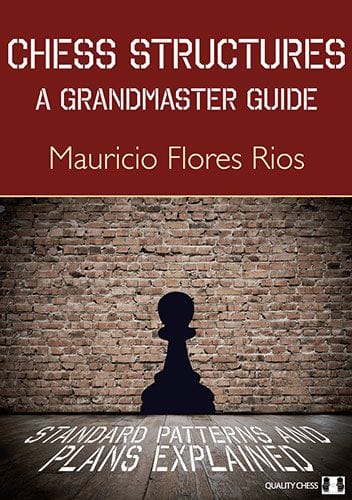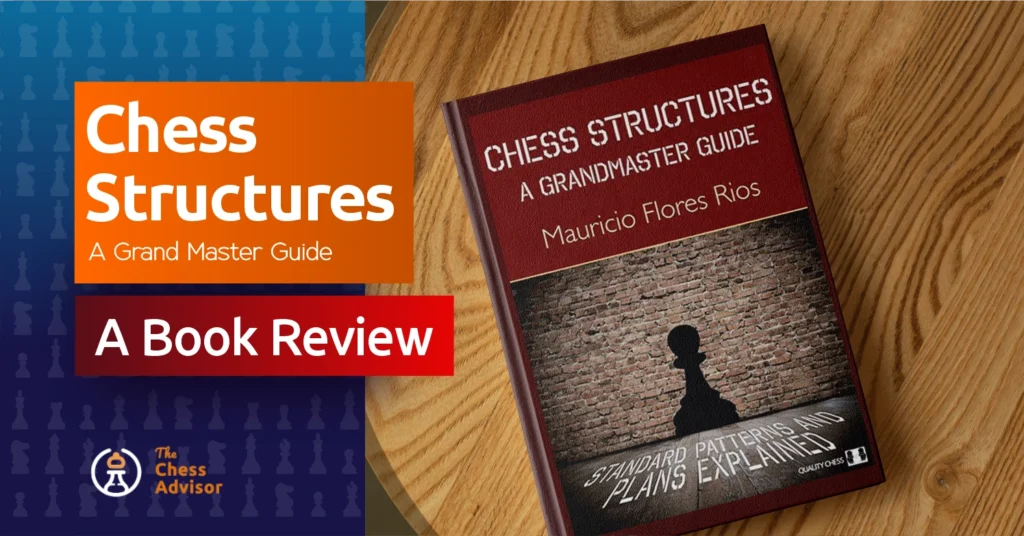Most chess books promise improvement. A few actually deliver. Chess Structures: A Grandmaster Guide is one of the rare few.
Written by Chilean Grandmaster Mauricio Flores Rios, this 2015 classic has steadily earned its place as an essential reading for players looking to sharpen their positional understanding.

But what makes this book stand out in a market flooded with flashy opening novelties and tactical puzzle compilations? The answer lies in its clarity, practicality, and the author’s deep knowledge of pawn structures.
Let’s get into why this book has become a modern favorite.
What’s the Book About?

At its core, Chess Structures teaches you how to handle 28 of the most common pawn structures in chess.
These aren’t random formations; they occur again and again in real games, from club level to elite grandmaster battles.
Flores doesn’t just explain what moves to play. He teaches why certain ideas work in specific structures, what plans to pursue, which pieces to trade, and which squares to fight for.
It’s structure-first, not opening-first. This alone sets the book apart.
The approach makes sense: if you understand the pawn skeleton of a position, you can almost “feel” the right moves, even if you’re out of theory early into the game.
How It’s Structured
Each chapter in the book covers one specific pawn structure. The format is consistent and easy to follow:
- Introduction to the structure: where it comes from and what it looks like.
- Strategic goals for both sides: who wants what and why.
- Model games: annotated deeply and clearly to illustrate key ideas.
Examples include classics like the Isolated Queen’s Pawn (IQP), Caro-Slav formation, Hedgehog, and Stonewall structures. Each section has just the right amount of depth without feeling overwhelming.
Flores selects games from a variety of players: Kasparov, Anand, Carlsen, and many lesser-known masters. This mix keeps things fresh while maintaining instructional value.
Why It Works
There are many reasons this book clicks with intermediate and advanced players:
1. Practical Examples
Flores doesn’t get lost in abstract theory. The games he selects are purposeful, with clear plans that can be applied in your own games. You won’t just watch the ideas happen; you’ll learn how to make them happen.
2. Clear Language
Despite being a GM-level work, the language is plain and instructional. No fluff. No grandstanding. Flores writes like a coach, not a show-off.
3. Repeatable Patterns
Once you study this book, you’ll find yourself recognizing structures over the board. Suddenly, you’ll know when to push a pawn, trade off bishops, or double rooks, not from memorizing theory, but from understanding what’s going on under the surface.
4. It’s Not About Openings
This is a big one. Many players get lost in opening preparation. Flores reminds us that understanding middlegame plans based on structure is far more important than memorizing move orders.
Who Is This Book For?
This book is best for players rated 1600 to 2300. Below 1600, the concepts might be too subtle. Above 2300, some chapters may feel basic but even titled players can gain from the clarity and instructive value.
If you’re a serious club player tired of memorizing openings without improving results, this is your book.
If you’re a coach looking for a structured way to teach positional play, also your book.
Highlights from the Book
Here are a few structures covered that stand out:
- Isolated Queen’s Pawn: You’ll learn how to squeeze, blockade, or mobilize this central tension point.
- Hedgehog: The legendary spiky setup will finally make sense after reading Flores’ breakdown.
- King’s Indian vs. d4 Structures: You get detailed insight into how Black can fight back against space using tactics from the King’s Indian Defense.
Flores does a good job of pointing out when ideas apply and when they don’t and how to adapt.
What Makes This Book a Classic
This isn’t a trendy book about a hot new opening or flashy traps. It’s about real chess. About structure, plans, and ideas. The things that win games beyond move 20.
It teaches how to think, not what to memorize.
Flores brings the same energy and thoughtfulness that you’d want from a private coach. He doesn’t assume you’re a beginner, but he walks with you all the same.
Final Verdict
If you’re a tournament player who wants to level up your understanding of positional chess, Chess Structures: A Grandmaster Guide deserves a place on your shelf. It won’t magically raise your rating overnight, but it will sharpen your instincts and improve your decision-making.
You’ll start recognizing patterns faster. You’ll build better plans. You’ll understand why strong moves are strong, and that’s real progress.
Whether you’re climbing from 1600 to 2000 or pushing beyond the expert level, this book offers practical tools for long-term growth.
